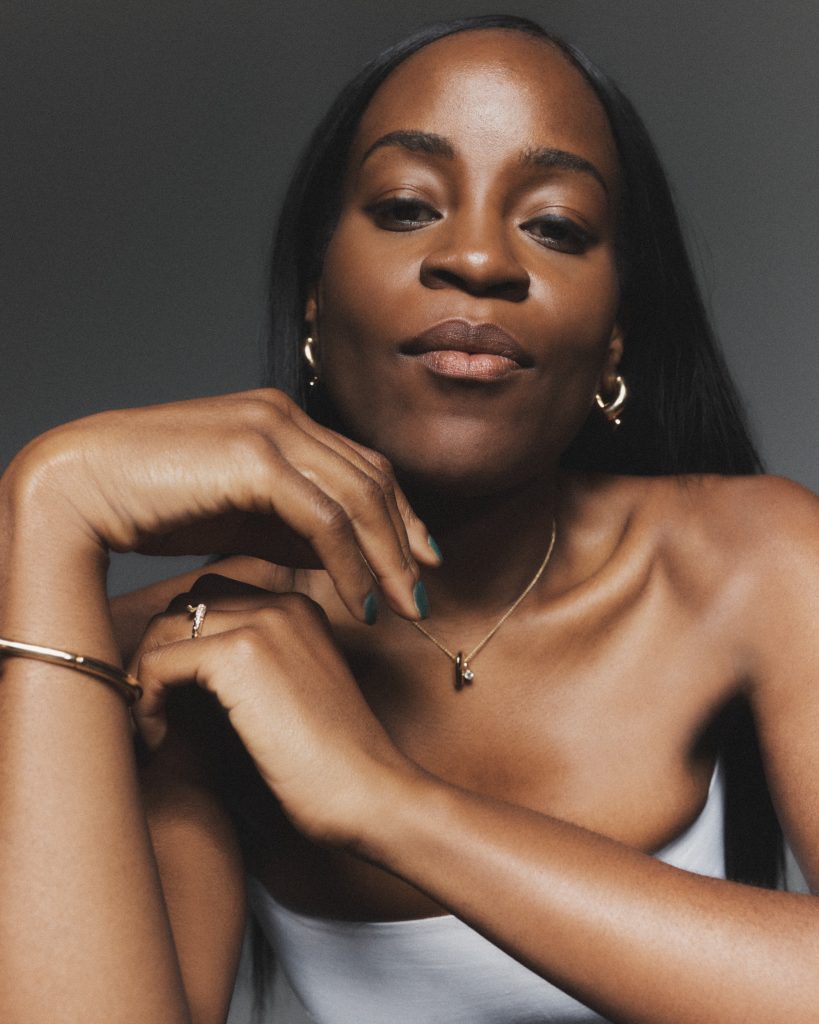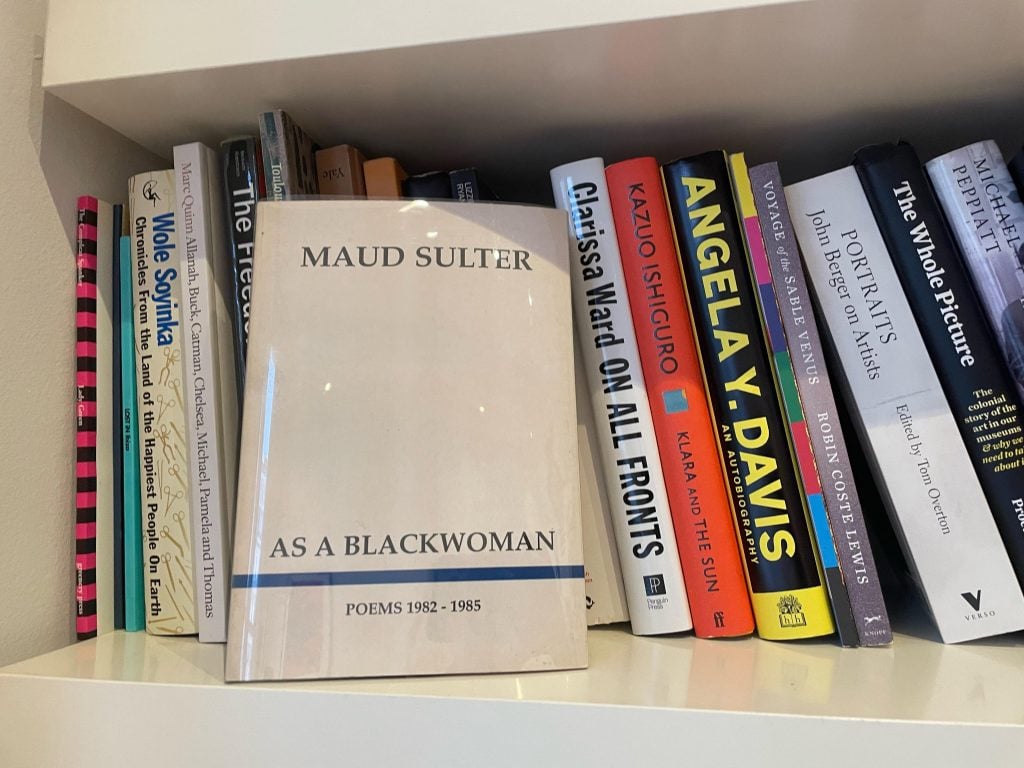Valuations
Curator and Historian Aindrea Emelife Prizes Daily Runs, Out-of-Print Books, and Discovering the New Generation of Nigerian Artists
We asked the Nigerian-British curator about the things she values most—in art and in life.

We asked the Nigerian-British curator about the things she values most—in art and in life.

Katie White

So much of the art world orbits around questions of value, not only in terms of appraisals and price tags, but also: What is worthy of your time in These Times, as well as your energy, your attention, and yes, your hard-earned cash?
What is the math that you do to determine something’s meaning and worth? What moves you? What enriches your life? In this new series, we’re asking individuals from the art world and beyond about the valuations that they make at a personal level.
Aindrea Emelife radiates passion. The Nigerian-British historian, curator, and writer’s enthusiasm has a way of illuminating beauty in overlooked places—she’ll mention an out-of-print book or tell an untold artist’s story in a way that is captivating and utterly contemporary. Over the past years, she has used this gift to reshape the art world. Trained at London’s esteemed Courtauld Institute of Art, she launched into the art world at full tilt. In 2014, she wrote her first column for the Financial Times at just 20 years old, and in 2021, was named one of Forbes’s “30 under 30” innovators to watch in arts and culture. In the years since, the ever-curious Emelife has penned articles exploring her myriad interests, from the booming contemporary African art scene to the importance of Faith Ringgold’s work, writing with her signature mix of academic vigor and artful approachability.
In the near decade since hitting the art scene, Emelife has shown no signs of slowing down. In 2022, she curated “Black Venus” at Fotografiska New York, an exhibition that explores the complex legacy of Black women in visual culture through the work of 19 international artists. A critical hit, the exhibition celebrated the many coexisting forms of Black femininity and beauty. Now “Black Venus” is on view at MoAD (Museum of the African Diaspora) in San Francisco. Later this summer, it will travel to Somerset House in London.
Then, earlier this year, Emelife was named curator of Modern and contemporary art at the much-anticipated Edo Museum of West African Art (EMOWAA) in Benin City, Nigeria. The David Adjaye-designed museum is the must-anticipated home for the Benin bronzes—artworks and artifacts removed from Benin by British troops in 1897—that have been repatriated.
All to say Emelife lives a very full professional life. When she steps away from her writing and research, she likes to reset either with a run or a trip to a good restaurant (just don’t offer her olives!). Recently we caught up with Emelife, who told us what she values in art and life—and why.

Courtesy of Aindrea Emelife.
What is the last thing that you splurged on?
A first edition of Maud Sulter’s poetry anthology, As a Blackwoman. I sourced this from Reference Point, the London bookstore. I am passionate about collecting out-of-print texts relevant to my research strands and Sulter, a Ghanaian-Scottish artist, has featured in many of my past projects, including “Black Venus” which is currently on display at MoAD in San Francisco and tours to Somerset House, London, in July.
What is something that you’re saving up for?
I’d love to purchase a ceramic work by Ladi Kwali. Kwali was a Nigerian ceramicist, born in the village of Kwali, which is part of the Northern Nigerian region called Gwari where pottery was traditional among women. I admire the beautiful dark glazes and incised decorative patterns—often of lizards. I was recently appointed as the inaugural curator of Modern and contemporary art at EMOWAA and exploring the enduring resonance of Nigerian female ceramicists has become one of my research strands.
What would you buy if you found $100?
I should probably be more profound but probably a great meal. I love food and how young chefs are using food to tell stories, explore history, and transform tradition. My current favorites are Michael Elegbede and ONA in Lagos. I am seriously into Japanese cuisine. I recently had a beautiful experience at SHION on Leonard St. when I was in New York. If $100 could take me to Japan, I’d use it for that.
What makes you feel like a million bucks?
Feedback! I praise social media for the accessibility it creates. Receiving DMs or watching Reels or TikToks of museumgoers in exhibitions I have curated is rewarding. It reminds me of purpose—it’s not about me, it’s about the community. Hearing from the people who feel moved enough to reach out makes me feel great because the work I do is not to add extra lines to my bio—I want to bring history and art to people’s lives and create worlds that nourish people with ideas and philosophies that bring value to their lives in the way art does for me daily.
What do you think is your greatest asset?
My curiosity, my youth, and my ambition. I have big hopes and dreams. My ambition is rooted in expanding narratives related to West African and Diasporic art. It is no small task, but I am honored to be part of this legacy.
I used to think my youth was a disadvantage—but as I progress through my career, and as museums negotiate with refashioning objectives and renegotiating what a museum of the future looks like, I value being able to exist as an academic but also within the demographic that is at the heart of this discussion. As I fear a self-centric life, I listen and consider carefully what the next generations look for from museums and how that is integrated into exhibition display, messaging, and focus.
I am curious about everything, which is why a career path as an academic is well-suited. I can read and research endlessly, and what makes me excited is ideating how I can bring these stories, ideas, canons of art, and perspectives to the widest of audiences. How can art be more relevant to more people, more often? How can it reshape how we see and catalyze introspection? How can it help us learn more about ourselves and humanity?
What do you most value in a work of art?
An understanding of history and of art history. I am a firm believer in looking back so we can understand the present and future. As I consider this, I think of the Ghanaian idea of Sankofa, or turning back to retrieve something from the past. Sankofa is symbolized by a bird with its head turned backward as its feet face forward, holding a precious egg in its mouth. The best art nods to the past, and has its feet firmly rooted in the present—seeing the possibilities of the future through an artist’s eyes and having your perceptions of yourself and the world challenged is important. Like any good opera, piece of music, or memory, it must stay with you long after the curtains close or you leave the museum.
Who is an emerging artist worthy of everyone’s attention?
I have a list. I love what New York artist Patrick Eugene is doing. He has a fabulous exhibition at Mariane Ibrahim’s gallery in Chicago. I think Nengi Omuku and Okiki Akinfe are brilliant. I recently visited Nengi’s studio in Lagos. She paints otherworldly scenes, often transformed from Nigerian press imagery onto vintage Sanyan, a traditional Yoruba fabric made from woven threads of wild moth silk and cotton. More than paintings, they hang away from the wall and serve as ethereal portals into history and lost imagined worlds.
Who is an overlooked artist who hasn’t yet gotten their due?
Again, I have a list. Understanding artists who have been overlooked and being part of establishing this canon is part of what I find most exciting in my role as curator at EMOWAA. The museum has a big role to play in expanding what we know and filling in the gaps in art history. It is an honor to work with these legacies—firstly, my research will be focused on Nigerian Modernism.
Any of these artists have not yet gotten their due, though they are beginning to: Bruce Onobrakpeya’s first US solo exhibition has recently opened at the High Museum of Art in Atlanta. Demas Nwoko has received the Golden Lion for Lifetime Achievement at the Venice Architectural Biennale and the catalogue of the recent exhibition “African Modernism in America”—co-organized by Fisk University Galleries in Nashville and the American Federation of Arts, New York, remains well-thumbed on my desk.
I have also been well embroiled in the work of Uche Okeke, an artist who worked between the waning of British colonialism and the emergence of political independence. He was key in formulating a new Modernist aesthetic, which he detailed in his manifesto, calling for a “Natural Synthesis.” In his mind, this would assert a dual purpose of relating to “ancient tradition” while also referencing a global artistic language, and so furthering Black and African modernity. His drawings are inspired by uli, a dying Igbo tradition of elegant linear mark-making practiced by women, which he saw from his mother. These designs often adorned their bodies or walls as murals.
I hope nobody accuses me of being biased—I am both Igbo and Yoruba!

Courtesy of Aindrea Emelife.
What, in your estimation, is the most overrated thing in the art world?
There are a few artists I think we could press pause on, exhibition-wise…I do sometimes feel there’s a lot of ‘safe’ repetition of the same sorts of exhibitions, especially when there is so much yet to discover.
What is your most treasured possession?
My passport. I am lucky enough to travel often—which is strange to me. Whenever I am tired, rundown, or jetlagged from travel, I remember my younger self who hadn’t really traveled at all until the age of 21. She wouldn’t believe that travel is an intrinsic part of my career now and that I get to work with incredible historians and academics and expand my worldview in ways I could never have imagined. It is important to remind myself of this and be humble. Travel is always a blessing.
What’s been your best investment?
Renting a place of my own. Growing up in social housing, I always dreamt of a place I could decorate and that could be my little sanctuary. As an only child and a very autonomous person, I love my little home. It’s filled with books—on the floor, overflowing from bookcases warping at the weight of thickly bound books, artwork gifts from friends, and lots of sentimental things. I’m not as much of a social animal as it may appear—I love people, but my ideal evening is absorbing conversation and cooking a meal for friends.

Courtesy of Aindrea Emelife.
What is something small that means the world to you?
Running. I run every day. It clears my mind, I dream, I hope, I come up with ideas. If I can manage it, I love trail running. Anything to get me moving and be with nature. I’d love to camp or hike somewhere beautiful in Africa someday.
What’s not worth the hype?
Olives. People love olives—I really don’t like them outside of a martini.
What do you believe is a worthy cause?
Expanding history and preserving our planet and its natural beauty. Both are related: they are ways to connect to ourselves as humans.
What do you aspire to?
To understand myself better, and my own subjectivity. And to expand the way we all see ourselves. The late Okwui Enwenzor did that for me. He will always be an inspiration.